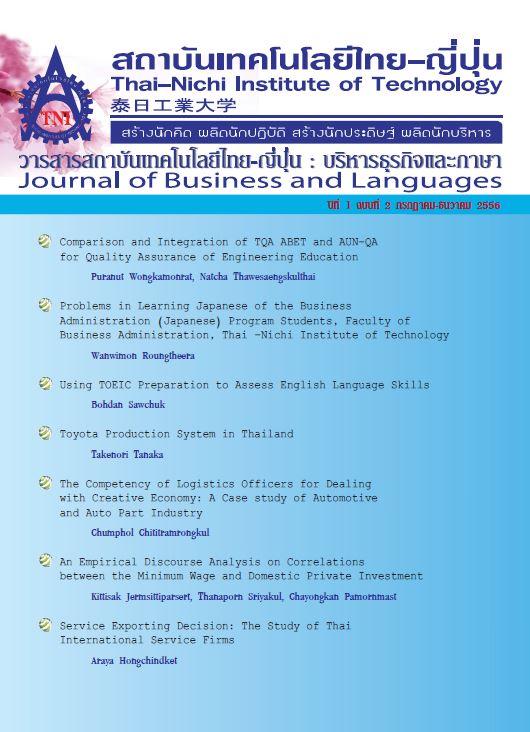The Competency of Logistics Officers for Dealing with Creative Economy: A Case study of Automotive and Auto Part Industry
Main Article Content
Abstract
The objectives of this research are to study concept, theory about significant competency of logistics officers for dealing with creative economy and determine significant competency of logistics officer for supporting creative economy in auto part and automotive industry. This research is qualitative research based on existing information and in-depth interview information for supporting data accuracy by concerned parties and for proceeding content analysis. The sample group of this study are included topic-related specialists and officers, logistics specialists in auto part and automotive industry and logistics officers.
The finding found that the top five necessary competency list of logistics officers for supporting creative economy in academics’, logistics specialists’ and logistics officers’ point of view are as following organization knowledge, team-work, action plan, external communication skill. Regarding the necessary competency for positions in logistics, officers should have specific knowledge in logistics and be effectively able to apply for duties (logistics main activities). Moreover, officers should be able to adapt skills for specific job. For logistics officer , the most important necessary competency are action plans competency such as being able to set suitable goal and developing achievement process as well as setting work priority for determining suitable main work and minor work. Secondly, organization knowledge is included vision, target strategy, policy, system structure, organization culture, market segment status, competition, financial, sales plan, and regulation for running company. To improve the management and team-work way, the competency in position should be mostly paid attention about inventory management and material management, especially logistics innovation such as RFID applied for inventory management and material management by considering continuity of material source, use quantity, and transportation method. The next considerations are inventory management in developing and improving warehouse mode to be distribution center or Cross-Docking transportation and warehouse activities respectively
Article Details
Article Accepting Policy
The editorial board of Thai-Nichi Institute of Technology is pleased to receive articles from lecturers and experts in the fields of business administration, languages, engineering and technology written in Thai or English. The academic work submitted for publication must not be published in any other publication before and must not be under consideration of other journal submissions. Therefore, those interested in participating in the dissemination of work and knowledge can submit their article to the editorial board for further submission to the screening committee to consider publishing in the journal. The articles that can be published include solely research articles. Interested persons can prepare their articles by reviewing recommendations for article authors.
Copyright infringement is solely the responsibility of the author(s) of the article. Articles that have been published must be screened and reviewed for quality from qualified experts approved by the editorial board.
The text that appears within each article published in this research journal is a personal opinion of each author, nothing related to Thai-Nichi Institute of Technology, and other faculty members in the institution in any way. Responsibilities and accuracy for the content of each article are owned by each author. If there is any mistake, each author will be responsible for his/her own article(s).
The editorial board reserves the right not to bring any content, views or comments of articles in the Journal of Thai-Nichi Institute of Technology to publish before receiving permission from the authorized author(s) in writing. The published work is the copyright of the Journal of Thai-Nichi Institute of Technology.
References
R. Florida. 2002. “The Rise of the Creative Class”. New York: Basic books.
Gary Hamel. & C.K. Prahalad.1994. Competing for the future. Massachusetts: Harvard Business School Press. McClelland, D.C. 1973. Testing for competence rather than for “intelligence.”American Psychologist, January, 1-14.
สมบัติ กุสุมาลี. 2553. ปัจจัยขับเคลื่อนเศรษฐกิจสร้างสรรค์ ริชาร์ด ฟลอริด้ากับตัวแบบ 3T. For Quality Management (ปีที่ 16) ฉบับที่ 150, หน้า 95-99
ทวีศักดิ์ เทพพิทักษ์. 2550. การจัดการโลจิสติกส์. เอ็กเพิร์สเน็ต. กรุงเทพมหานคร
McClelland, D.C. 1973. Testing for competence rather than for “intelligence.” American Psychologist, January, 1-14.
พอร์เตอร์, ไมเคิล อี. 2546. รายงานการศึกษาพัฒนาขีดความสามารถในการแข่งขันของไทย. สำนักงานคณะกรรมการพัฒนาการเศรษฐกิจและสังคมแห่งชาติ. กรุงเทพมหานคร
Gary Hamel. & C.K. Prahalad. 1994. Competing for the future. Massachusetts: Harvard Business School Press.
Spencer, L. M. & Spencer S. M. 1993. Competing for the suture. Massachusetts: Harvard Business School Press.
Green, P. C. 1999. Building robust competencies: Linking human resource systems to organizational strategies. San Francisco, CA: Jossey-Bass.


